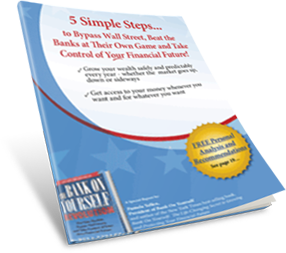
A cabin in the woods makes a nearly ideal setting for a conversation on topics that range from the general to the highly personal. This particular cabin is a small, rustic cottage with pine wood paneling and a stone fireplace, in the Blue Ridge Mountains of North Carolina, at an elevation of 4,800 feet. The setting offers a view to a distance of about one hundred miles, across thousands of acres of preserved forest as well as three ski slopes.

This tranquil, rugged property is owned by software sales manager Bill Liebler, along with his wife, Meloney, and two of the Lieblers’ friends. When I spoke with Bill by phone, he described their acre of land as offering “nothing but hardwood trees and rocks with tons of deer and wild turkey and other critters running around.” Does that suggest Bill might be a hunter? Quite the opposite:
I’m married to a tree-hugger, so if I showed up with a dead animal, I’d be the next one shot. It’s a place for trout fishing, golfing, and mountain hiking. And for just getting away. We love the mountains.”
For most people, forty-seven years old would seem to be late in life to begin thinking about funding a child’s college education. But not for Bill Liebler. Seventeen years into their marriage, the couple received a happy surprise…
“We just assumed all those years that we couldn’t have children. My father-in-law was a Baptist minister. After he retired, he was diagnosed with cancer. He passed away thirty days later, and about six months after that, my wife was pregnant.
I just figured we needed to do some ‘networking’
Not long ago I wrote an article for a friend of mine’s Web site called ‘First-Time Fatherhood at a Medically Advanced Age.’ So I do have a sense of humor about it, but I also realize I’m going to be sixty when my daughter starts college. When she finishes undergrad school, we’ll be sixty-four or sixty-five.”
(Note to everyone thinking of giving up on starting a family late in life: Bill says having Shelby in their lives is “just a lot of fun.”)
The most common methods used by families saving for college for their youngsters include traditional investment and savings accounts, UGMAs (Uniform Gift to Minors Accounts), and 529 college savings plans (so called after the section of the Internal Revenue Code that sets out the rules for this type of college savings; they are also known as qualified tuition plans). Not knowing at the time that there was a better way, the Lieblers started funding a 529 plan for Shelby’s college.
That changed after Bill learned about B.O.Y. and was referred to a Bank On Yourself Professional…
“When my Bank On Yourself Professional and I first sat down to talk about this, I told him my plan was to fund the 529 plan for the first few years as aggressively as I could. Things were going pretty well income-wise, so I figured, ‘Fund it while you’ve got some extra cash flow.’
Free Special Report
Have you received our FREE report detailing what Bank On Yourself is and how it works? Grab your free copy here!
I had planned all along to fund it for four or five years at a certain rate, and put money from Grandma into it, too. My advisor said, ‘I’m not a big fan of these 529 plans because of the restrictions. They’re not very flexible.’ He’s right.
Let’s say your child gets a scholarship. If you’ve got a 529 plan, you don’t need it anymore because of your child’s scholarship, but there are restrictions against using the money for anything but education. Or if Shelby doesn’t go to college, with her being an only child, my wife and I would have to go take some college classes with the money in a 529 plan, or wait until we’re fifty-nine and a half to avoid paying penalties.
Otherwise we’ll have to pay taxes on the gains as well as penalties to use that money.”
Bill’s advisor expanded on the explanation:
“The beautiful thing about using Bank On Yourself as the alternative is that if the child doesn’t go to school or gets a scholarship, then you’ve got additional money you can use for your retirement, or however and whenever you want, for that matter. And the money can do double duty by your taking out a policy loan and using it to remodel your kitchen or whatever, as opposed to a 529 plan, which cannot be used that way.”
College funding alternative?
Using a Bank On Yourself plan to finance a college education gives you flexibility and many advantages you don’t get with a 529 plan, UGMA, investment, or savings account.
“With a B.O.Y. plan, you don’t have the risk of loss due to market fluctuations. What if you’re saving in a 529 plan, and the market tanks shortly before your child is ready to go to college? Now what are you going to do?”
Bill chimed in:
“That’s a great point. Shelby’s 529 plan is down this year. Not only is it inflexible when it comes to how you can use the money, but also how you can invest the money. I can’t easily pick up the phone and call a broker and say, ‘The market’s tanking. Get out of those mutual funds and put it in cash or bonds.’ You have to move it between funds. With B.O.Y., I never even have to worry about that happening.”
Bill discovered still another advantage: If you want to apply for college financial aid for your child, the money in the B.O.Y. policy does not count against you for financial aid.

This means that when you list your assets on the Free Application for Federal Student Aid (FAFSA), you could have $100,000 cash value in your B.O.Y. policy, or several hundred thousand, but it would not count against you for the purposes of judging whether you qualify for college financial aid or scholarships. The same amount of assets in regular savings accounts, UGMA accounts, stock market accounts, or real estate could make your youngster ineligible.

Also, as mentioned earlier, when you take retirement income from a B.O.Y. plan, it’s not counted toward your earnings limit for Social Security-it won’t cause you to lose Social Security benefits.
As you can guess, once Bill discovered all the strings and restrictions that came with his 529 plan, he stopped funding it and started funding a B.O.Y. plan instead. Now he’s in the unique situation of having friends and coworkers his own age with kids ready to start college who didn’t know about B.O.Y. and used conventional college funding methods. As Bill put it:
“The last thing that we would want to be staring at now, like a number of my friends are who are my age with kids going into college, is they are coming out of college and not only are the children holding a big loan, but the parents have either refinanced their house or they’ve taken out a home equity credit line or they’ve taken out college loans. They’re starting to pay off those loans over a period of time and that’s taking away from their lifestyle and their retirement.”
A lot of my friends who didn’t know about B.O.Y. are now paying off loans they took for their kids’ college education and it’s taking away from their lifestyle and their retirement. That’s the last thing we’d want to be staring at now.”
Bill continued, “It can be pretty daunting. One of my friends has done this in a very logical way. He and his wife have six kids. Three of them are out of college, one just finished, and the other two are finishing up. He and I have had some pretty long talks about that, and how they’ve been able to juggle things versus what the kids have taken on.

He and his wife have struggled, refinancing the house and pulling out some money and also feeling uncomfortable that all six of his children are coming out of college with at least some degree of student loan debt and knowing that they’ve got to start their working life that way. It was a constant juggle of cash flow and making decisions about what they could and couldn’t do. It really produced a limiting factor on their lifestyle and budget. Not that they would trade it for their kids in any way, but that’s just the financial reality of the story.

They had them go to state schools. They’ve done a lot of things, but you look at six kids times, who knows, $60,000? They’ve probably spent between $250,000 and $300,000 to send them to school.
I had student loans coming out of college, so I don’t think that’s a terrible route to go, but at the same time you look at that and know it’s not a good way to start off your working and financial life. That clearly was a big factor in working with my advisor on deciding to use B.O.Y. to fund Shelby’s college.”
Making your college savings money do double duty for you
Bill then explained how he was making his B.O.Y. plan work even harder by using the equity in his plan to finance other things, while building the money to pay for Shelby’s college:
“I just borrowed $40,000 from my B.O.Y. plan; $26,000 of that we used to pay for the new car we just bought for my wife. We’re ‘drive cars until they die’ people and hers was eight years old. It’s pretty cool. It’s like writing ourselves a check every month. It’s not just that we’re paying ourselves back, it’s also an investment into our future.
It’s also knowing that if something goes bump in the night, or cash flow is tight for a month or two or three, I could delay making some payments and not have somebody breathing down my neck.”
And what did Bill do with the remaining $14,000 he borrowed from his plan?
“As part of buying our vacation cabin, my two partners and I are having the basement finished and putting a deck on and a hot tub in. I used the other $14,000 I borrowed to pay for my part of finishing the basement, so now I’ll be paying myself back.”

The conversation then turned to the market conditions at the time of the interview, in spring 2008. Referring to the value of his stocks, Bill said, “It goes down by the day.” The comment led me to share a story about what had recently happened in my own household. One evening after dinner, I heard my husband, Larry, yelling from the den, “You’ve got to get over here, quick. I just can’t believe this. You’ve got to see this!” He was pointing at his computer screen looking like he’d seen a ghost. He had discovered that our pension plan had lost over $6,700 in just that one day.

We had this deal that neither of us was going to look at our plan balances more than once every few months, and we’d checked it out a few weeks before, so I’m standing there going, “What are you doing looking at that? Why are you torturing yourself?” The plan had lost 25 percent over the previous year and a half, the value of our home was down 22 percent, and Larry was saying, “We can’t afford these kinds of losses now-we’ve only got ten years left until retirement.”
I had to grab the file I keep of annual statements from all eighteen of our Bank On Yourself plans and show him how much each one had increased over the past year, between the guaranteed cash value increase and the dividends. One plan had gone up the previous year by more than two and a half times our annual premium (which stays constant throughout the life of the policy). And nine years from now, when I turn sixty-four, that plan is projected to increase by around five times the annual premium.
Every one of our family’s eighteen B.O.Y. plans increased more this year (as the stock and real estate markets were tanking) than they did last year. One plan went up by more than two and a half times our annual premium, and nine years from now, when I turn sixty-four, that plan is projected to increase by five times the premium, based on the current dividends.”
After I told that story, Bill Liebler shared one of his own:
“I have a friend who I have that same conversation with. ‘Oh, man, have you looked at what happened?’ I told him to quit looking at that. It’s going to drive you crazy. Quit killing yourself! Unless you’re going to rebalance it or do something about it, don’t look at it.”
Bill then went on to talk about switching from his savings and investing plans to Bank On Yourself…
“I think the biggest thing is the ability to leverage your own money in a way that is very safe and secure. B.O.Y. is a very good vehicle that allows you to have some predictable growth and then be able to leverage that money while still getting that growth.
And when you look at buying cars or at doing this or that-where does the money come from? Well, I either have to pull it out of savings or investments and pay cash, or I’ve got to go borrow money and then somebody else is making money on that money.
 That’s when the light bulb went on. It just really seemed like a vehicle that lets you live your life and make the kind of decisions you make every day, knowing that you aren’t putting a portion of every check into a banker’s pocket and the rest into the equity of whatever it is you want to acquire, whether it’s a car, or a boat, or a timeshare, or a long-term investment, like our cabin is for us.
That’s when the light bulb went on. It just really seemed like a vehicle that lets you live your life and make the kind of decisions you make every day, knowing that you aren’t putting a portion of every check into a banker’s pocket and the rest into the equity of whatever it is you want to acquire, whether it’s a car, or a boat, or a timeshare, or a long-term investment, like our cabin is for us.
With B.O.Y., that money is going right back in to fund your next project or next purchase.”
The bottom line is that Bank On Yourself is about knowing the money will be there when you need it.
A Bank On Yourself Professional (a life insurance agent with advanced training on this concept) can show you the details and explain the nuances of using your plan for college expenses. Just fill out the simple Analysis Request Form today.
At the same time, Bill understood how all the myths and misinformation the public has been exposed to about insurance can be hard for some people to overcome:

“The insurance wrapper that goes around B.O.Y. has to scare away some people, I’m guessing. But after you read enough and you think about it enough, you understand that this is the only vehicle that gives you such a good deal.”

